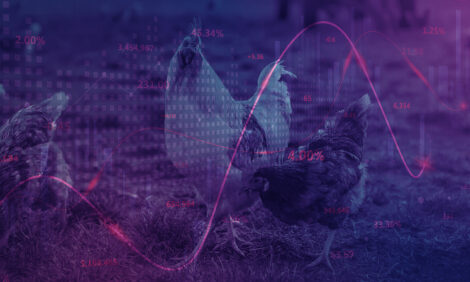



India Poultry and Products Annual Overview - August 2005
By the USDA, Foreign Agricultural Service - This article provides the poultry industry data from the USDA FAS Poultry and Products Annual 2005 report for India. A link to the full report is also provided. The full report includes all the tabular data which we have ommited from this article.Report Highlights:
Post forecasts India’s 2006 poultry production to grow by 16 percent to 2.2 million tons, assuming better feed availability, the growing preference for birds with higher dressing yields, and relatively stable poultry meat prices.
Production
India's broiler production is forecast to grow by 16 percent to 2.2 million tons in CY 2006, due to the likely larger availability of feed and the growing demand for poultry meat in response to affordable prices and rising consumer income. A trend toward forward integration in poultry operations, growing farmer preference for birds with higher dressing yields, and price stabilization measures initiated by the industry are also factors supporting production growth.
Production Developments
The broiler industry’s forward integration, which had been confined largely to southern India,
is now spreading into northern India due to higher profits for entrepreneurs, stable income
for growers, and better production controls. Under this system, growers receive day-old
chicks, feed, medicines, other services, and the assurance that their birds will be purchased
at a contracted price. Input costs are deducted from the payment to the grower, and they
are given an incentive bonus if the feed conversion rate (FCR) and/or mortality rate is better
than the contracted level. This arrangement has encouraged a number of small farmers to
enter the poultry business in order to supplement their income with a stable return on their
investment.
Heavy losses incurred in north India in 2004 due to the Asian bird flu prompted poultry
growers in this region to embrace vertical integration to revive the industry. These poultry
farmers have now started paying increased attention to FCRs and nutrition and quality
standards for feeds. In some areas, vertical integration was extended up to the retail level
to improve profitability and to make poultry meat more affordable to consumers. It also
helped entrepreneurs to control meat production through better-coordinated efforts aimed at
overcoming problems of seasonality (less poultry is consumed in summer and during certain
religious festivals).
Only, about eight percent of total poultry meat production in 2004 was processed, as
consumers still prefer fresh meat. With rising incomes, changing lifestyles, and increased
promotional efforts to popularize processed meat, its share is estimated to increase to nine
percent in 2005. Many of the poultry integrators already have built, or are building, poultry
processing facilities to produce chilled and frozen meat and products for the institutional and
the retail segments. Some are looking at export possibilities to Asian and Middle Eastern
countries by reducing costs and introducing strict bio-security measures.
Consumption of compound feed continues to grow alongside rising awareness among
growers about its nutritional qualities and feed conversion efficiency, and is estimated at 4.8
million tons in 2004. According to trade sources, comparatively lower prices for soybean
meal led to its increased usage in 2004, estimated at 1.5 million tons, up 15 percent over
2003. Corn prices remained higher due to lower production, with prices currently at $141
per ton. Industry sources estimate corn requirements by the compound feed sector to reach
15 million tons by 2010.
Consumption
Post forecasts poultry meat consumption in 2005 at 1.9 million tons, or 1.8 kg per capita. It
is the major meat consumed in India and has wider regional acceptance, given the high price
of mutton, cultural restrictions on consumption of pork and beef, and fish largely being
confined to the coastal regions. Lower retail prices, resulting from expanding vertical
integration, have also stimulated consumption. Integrators have established wholesale-and
retail-price leadership in their markets, mostly in south India, by reducing the number of
middlemen and forcing wholesalers and retailers to reduce their margins. In other regions,
particularly in the northern region, where the traditional wholesale traders still dominate the
markets, the marketing margins and retail prices are considerably higher than in the south.
The Indian poultry industry remains primarily live bird-oriented, although there is a growing
market for chilled products, especially in the restaurant and hotel sector. Most birds for
home consumption are purchased live and slaughtered in small local shops. Movement of
live poultry from the low-cost growing areas to high-cost consumption areas is constrained
by the high mortality and high transport and shrinkage costs. This results in significant price
variations. Frozen poultry meat product consumption is restricted by inadequate cold
storage facilities, a lack of consumer preference, and high import duties. Although a shift
toward chilled products is likely to continue in urban areas, in part due to slaughter
restrictions imposed by major cities like Delhi due to waste disposal problems, frozen product
demand growth will likely remain weak over the near-to-medium term.
Production Policy
Poultry receives far less government assistance than other agricultural sectors, a situation that limits the growth of the industry. It does not receive any government production subsidy. Poultry businesses are taxed at the same rates as industry, whereas agricultural income generally is tax-free. However, the government funds poultry research by government institutions and universities, and the Agricultural and Processed Products Exports Development Authority (APEDA) assists with infrastructure development for export. APEDA also provides an airfreight subsidy for exports of eggs and egg products, mostly to the Middle East. Poultry meat exporters are asking for the extension of airfreight subsidy for poultry meat, but their efforts are unlikely to succeed. Total government support for the poultry sector was rs. 105 million ($1.8 million) in Indian Fiscal Year 2004/05 (Apr-Mar), compared with rs. 98 million ($1.6 million) in 2003/04.
Trade
Table egg and egg powder exports from India are increasing due to cost competitiveness,
improving hygiene standards, and logistical advantages. Poultry meat exports are relatively
small, due to India’s higher cost vis-à-vis Brazil, although several efficient poultry integrators
are currently exploring the possibility of exporting to lucrative markets such as Japan, South
Korea, and the Middle East.
Although there are no quantitative restrictions on imports of poultry meat, numerous
unjustified sanitary conditions and high import tariffs constrain imports. Government policy
allows imports of grandparent breeding stock and pureline stock on the basis of special
permits issued by the Department of Animal Husbandry, Dairying, and Fisheries, Ministry of
Agriculture. Grandparent hatching eggs and grandparent day-old chicks attract a 30.6
percent tariff. Feed additives such as lysine, methionine, and choline are mostly imported,
as are Specific Pathogen Free eggs and vaccines and vaccine-related raw materials.
Market Opportunities
Despite increasing vertical integration and private investments in the poultry industry, most
integrators do not have their own grandparent operations and are therefore potential regular
importers of breeding stock. Most of the existing broiler breeds derive from American strains
such as Cobb, Hubbard, Arbor Acres, and Hyline. The current changes in production
conditions also provide an opportunity for US-based pureline genetics companies to start
breeding operations in India. Although India is currently self-sufficient in corn, trade sources forecast that the corn demand may outstrip supplies by 2010, creating export opportunities
for US corn.
Further Information
To read the full report please click here
Source: USDA Foreign Agricultural Service - August 2005








